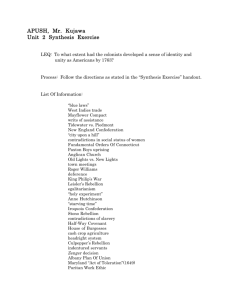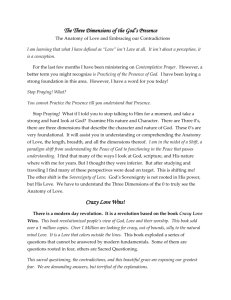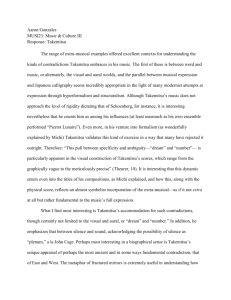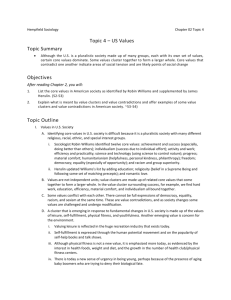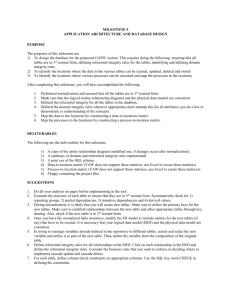By Force of Argument
advertisement
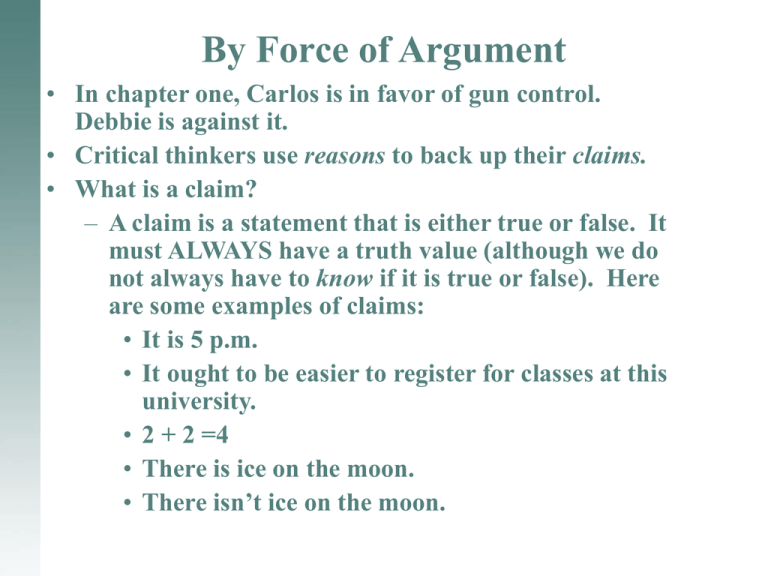
By Force of Argument • In chapter one, Carlos is in favor of gun control. Debbie is against it. • Critical thinkers use reasons to back up their claims. • What is a claim? – A claim is a statement that is either true or false. It must ALWAYS have a truth value (although we do not always have to know if it is true or false). Here are some examples of claims: • It is 5 p.m. • It ought to be easier to register for classes at this university. • 2 + 2 =4 • There is ice on the moon. • There isn’t ice on the moon. Claims – Moore and Parker • The official job of claims is to communicate information. But, in fact we use claims to accomplish a variety of goals. • Oftentimes we communicate a fact to others when our main interest is not simply to make them aware of the fact but rather to persuade them, warn them, amuse them, comfort them, or annoy them. • When we are confronted with a claim, we can respond in lots of ways. We can ignore the claim, or we can consider it. We can question or challenge it. We can criticize, defend or make fun of it. Usually, though, what we want to do is determine whether to accept it (that is, believe it), reject it (believe that it is false), or suspend judgment about it (possibly because we don’t have enough information at the time to accept or reject it). Claims II – Moore and Parker • When we accept or reject claims, we do so with varying degrees of confidence: We may have full confidence in the truth (or falsity) of one claim but only modest confidence in the truth or falsity of another. The degree of confidence in our acceptance or rejection of a claim should depend on the amount of evidence we have for or against a claim. Could knowing less be a reasonable goal for a critical thinking course? – David L. Fairchild • “This claim may be less extreme than it first appears, Part of what is at issue here involves a distinction between appropriate and inappropriate ways of using “know.” We sometimes claim to “know” things that we only believe, for example, or things that we wish we knew or that we would like someone else to stop talking about. Sometimes we use “know” deliberately, to preclude further discussion of a topic about which we are unsure of or with which we are uncomfortable. If becoming better reasoners entails becoming more precise in our epistemological vocabulary, we may well claim the result of “knowing” less after the experience than we did before. Opinions • Statements such as “You and I just feel differently about it” or “One person’s opinion is as good as another’s” evade the issue. • M & P: It is important to watch out for the words: “Everyone is entitled to his or her opinion.” It is true, in some sense, everyone is entitled to his or her own opinion on anything. The reason for this is that in anything except a complete dictatorship, people are not forced to hold a given set of opinions. It is hard to force someone to hold a certain opinion. But the fact that we do not force people to have this or that opinion on a subject does not mean that one opinion may not be more intelligent, much more practical, much more humane than some other opinion. Indeed, some opinions are so bad, stupid, or dangerous that it may be hazardous or even immoral to hold them. The Rational Argument • To present a rational argument, offer reasons to back up your claims. • Engage in honest debate, testing your opinions against others to determine who is correct. • We don’t want to fool others or ourselves into accepting something that has no real foundation. Rather, we want to believe things with good reason. Avoiding Self-Contradiction • One of the most important elements in reasoning well is to maintain consistency. • We cannot claim one thing and also claim its opposite. • This principle of reasoning is called the law of noncontradiction – a rule formulated by Aristotle. Nothing both is and is not. • Contradictions can be divided into three types: – Contradictions in theories, in statements, and in thoughts. Contradictions in Theories • “Doublethink means the power of holding two contradictory beliefs in one’s mind simultaneously, and accepting both of them.” – George Orwell • The example in the book is two attitudes that somehow exist side by side in the American psyche. For example, we often maintain that hard-working individuals will eventually succeed. You can make it in this country with initiative, perseverance, and good sense. The corollary is that crooks will eventually get what they deserve. At the same time, we often believe the opposite. We believe that goodness is self – sacrificing. In business dealings, we have to be tough and look out for number one. The kind souls will get eaten alive. These are contradictory theories. Contradictions in Statement • Examples: • You can’t generalize. • As a Virgo, I’m very rational, so I don’t believe in astrology. • Albert Camus once remarked that the minute we declare “Everything is absurd” we contradict ourselves, for we have said something meaningful. Contradictions in Thought • Double binds - cases in which we are asked to think or feel two things that are impossible to maintain simultaneously. • For example, if we tell children that a treasure is hidden in the garden but they can only find it if they don’t think of a white rabbit while they are searching. The children will never find the treasure, of course (because it isn’t there), but we can explain this by accusing them of thinking of the white rabbit. Obviously, they cannot deny it. For they had to remember to forget a white rabbit. They had to keep in mind what they have to put out of their mind. Seeming Contradictions • Seeming contradictions are called pardoxes and oxymorons. • Paradoxes are statements that appear to be inconsistent, absurd, or opposed to common sense but may be true in a special or deeper meaning. - For example: In the book The Little Prince by Saint Exupery, the prince asks an alcoholic “Why do you drink?” The man answers, “To forget.” The little prince then asks “What is it you want to forget?,” to which the alcoholic replies, “The fact that I drink.” It sounds absurd but it is also true at a more fundamental level. Alcoholics find themselves in a downward spiral in which they drink in order to help ease the shame of being an alcoholic. Oxymorons • An oxymoron is a figure of speech in which opposite or incongruous words are put together to express a point more pungently. They are not conflicts in terms, but only appear to be. – For example, a deafening silence is not a selfcontradiction because a silence can be significant when a noise is expected. Self -contradictions Explain why the following statements are self – contradictions: • We can never know anything. • One thing I’ve learned is that you can’t generalize. • As a solopsist, I believe that I alone exist. I think everyone else should believe this too. • Evaluate this quote: – “I have forced myself to contradict myself in order to avoid conformity to my own taste.” – Marcel Duchamp How words have meaning • How do words acquire meaning? • If we want to know what a word means we might consult a dictionary. • Words are just squiggles on a page (or screen), or sounds that reverberate in the air. They can be decoded and encoded for understanding. Words carry meaning. • In a larger sense, of course, no inantimate thing can mean anything; only people can “mean” because we alone possess intentions. The Referential Theory of Meaning • The referential theory of meaning is the theory that a word stands for, represents, or serves as a label for various objects in the world. It names them, and enables us to understand each other by substituting the name for the thing. The theory maintains that words were created as an expedient way of referring to physical objects. • The word “tree” then, refers to a tree, “cloud” to a cloud, “rock” to a rock, and so forth. The referential theory is reinforced by the fact that we can translate words from one language to another, which suggests that people around the world engage in this same process of putting words to objects. In English, people invented the mark and sound “dog”, in German “der Hund”, and so forth. The Referential Theory of Meaning II • Persuasive as the referential theory sounds, it does not provide a complete explanation for how words mean. The theory may hold true for nouns and proper names, but it fails to account for conjunctions such as “and,” “or,” “as,” and prepositions such as “with,”, “before,” or “to.” No one has ever seen an “if.” Not all words represent physical objects, and yet these words have meaning. • Some words do not stand for anything at all, even indirectly, such as “Easter Bunny,” and “Unicorn.” Here we have creations of the human imagination. • Also, “The King of Brazil” means something even though no one fits the description. The overall point is that there are words that have meaning but do not represent any object, and if words can mean but not refer then referring cannot be the explanation for meaning. The Image Theory of Meaning • This theory claims that words mean by conjuring up images in our mind. • If the word “bank” is used we imagine a safe and solid building where money is deposited and withdrawn, loans are made, and various financial transactions are conducted. The words generate an image that people share when the communicate, and since people have experiences in common the images tend to coincide. However, miscommunication can occur if the image of the word is not the same for the speaker and the hearer. If “bank” triggers pictures not of a substantial building but of the sloping ground beside a river, then people will be talking at cross –purposes. The Image Theory of Meaning II • The theory of meaning as image has the same defects as as the referential theory. We cannot form an image of words such as “to,” “for,”, or “as,” and yet they have meaning. Furthermore, abstract terms also have meaning, but are not normally pictured. “Truth,” “love,” ‘integrity,” and so forth have no pictorial counterparts. • If we say “I intended to stay a short time, “ or “One should avoid making logical errors,” few of these words are pictorial, but the sentences do make sense. • These type of problems show that this theory is not comprehensive enough. If words can have meaningful without generating images, then images cannot be that which gives words meaning. Meaning and Use • In place of the referential or image theory, many contemporary thinkers prefer to interpret the meaning of a word as the conditions of its use. • To know the meaning of “after,” for example, does not imply some object in our mind’s eye, but knowing when the word may be applied . We can use “after” for whatever follows in time or order, that which is subsequent. It is also properly used to mean the object of an action (as in “go after the prize”), or in view of (as in “after all our advice”), or as resembling something(“she takes after her mother”). Once we have grasped the rules of usage, we know the meaning of the word. Meaning and Use II • This theory accounts for the meaning of conjunctions and prepositions as well as abstract terms. What’s more, it does not demand that all words stand for things, or that words have images to give them meaning. For words to mean something, the only criterion is that there be conditions that govern their application. This theory states that words have meaning in terms of accepted rules of usage. • This is the strongest theory, but it still has problems. Since we do feel, at least some of the time, that our words describe things as they are, the idea of meaning as nothing but use leaves us distinctly uneasy. That is, in some way language does seem to diagram reality and to more than a self-contained system of rules. Using Terms and Mentioning Them • Sometimes we refer only to the words themselves and not to what they convey. In these cases the word is being mentioned rather than used, and we set it off in quotation marks to indicate that. For example, when we write “Bob” is a palindrome we use quotation marks to show that the word itself is a palindrome, not the person Bob. • Separating when a word is being mentioned and when it is being used is important in conveying and understanding meaning. A word is not the thing it represents (assuming that it stands for something), just as a portrait is not the person. • When a teacher says, “If you can’t spell well you will get a poor grade,” it means something very different from “If you can’t spell “well” you will get a poor grade.



